NORTHERN LIGHTS and LODGE ADVICE
compiled from experience by Paul D. Maley
If someone tells you that seeing the Northern Lights is a bucket list experience, be sure to believe them. My first look occurred in 2012 and since then I have not been able to resist going back for more views. I began organizing small group expeditions on behalf of the Johnson Space Center Astronomical Society and the general public truly enjoyed the incredible views both in spring, fall and winter when the Lights are visible. Summer time features no aurora viewing at all due to the preponderance of daylight. The level of astonishment, satisfaction and response have been great and the appeal has been such that a number of participants have repeated travel multiple times. Even when the Lights are just dimly visible they make a positive impression.
We have conducted many trips primarily to Alaska and Scandinavia to view the aurora. One thing we have found is that if you are planning to observe from a particular hotel or lodge, certain practices need to be exercised by the hotel or lodge in order to ensure that your experience is going to be positive. In addition, below we provide a number of tips that will help you get ahead of the game before you take your first aurora photo. We insure that everyone in our group has proper expectations on what to expect and how to best see them.
THE FOLLOWING IS BASED MAINLY ON WINTER VIEWING. NORTHERN LIGHTS ARE NOT VISIBLE TYPICALLY BETWEEN LATE APRIL AND LATE AUGUST. FALL IS THE OTHER PERIOD WHEN THEY CAN VE VIEWED.
RULES OF THE LODGE
Shoes are not permitted inside except in the entryway. Use slippers or socks only. The room is generally cleaned once during your stay and you must put a sign on the doorknob indicating that you want it done. Hair dryers and conditioning shampoo are available and there is a TV with limited number of channels. There is a limited time to shower since the lodge is on a septic system, so be quick! The hair dryer can be used by photographers to blow moisture off camera lenses when coming in from the outside especially during the winter months.
NAME CHANGES BEFORE THE TRIP
Name changes are not permitted within 60 days or a $100 fee will be assessed by the ground operator.
TIPPING
Gratuities to lodge personnel or drivers, tour guides are NOT included and you can use your own discretion as to how much to tip. Normally tips are given to those people at the end of their service period or when you leave Alaska and last see those individuals. The amount of a tip may be shown on the tour web page.
WIFI
There is free wifi at our lodge but very limited upload and download capability.
PERSONS WITH MOBILITY ISSUES
Aurora viewing means going outside at night, walking to a spot and sitting down. Our primary viewing location is a walk down a hill with a moderately steep slope as shown in the image on your right.
If you are not able to walk by yourself down to the location then there are two alternatives.
OPTION 1: You can simply step outside your room onto the back driveway (above left photo) where you can take one of the two chairs (above right photo) outside each room and move them onto the driveway for viewing.
The lodge and trees will partly obscure viewing but otherwise it should be a good alternative to walking down to the yurt area where everyone else will congregate.
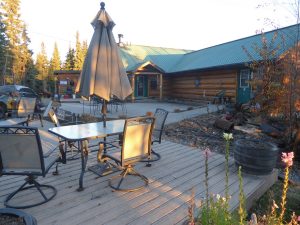
OPTION 2: If you have booked one of the two suites, then you walk out the front door to the front patio (photo to your right) and can watch from there.
Trees will obscure part of your horizon but otherwise you should be able to see the Northern Lights.
*Note that all of the main lodge rooms (except for the 2 suites) are located at ground level.
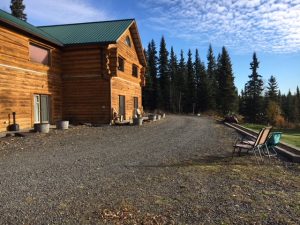
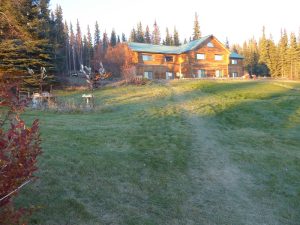
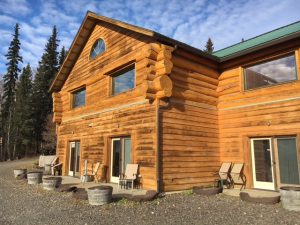
Generally there is little to no wind in Fairbanks during aurora viewing months. This is great because it means you have little to worry about from wind chill. However, it does get cold. Temperatures at night can dip to -25 deg F but usually are higher than that. You should prepare clothing for worst case conditions and layer so you can add/remove layers to assist with your comfort.
THE LODGE RENTS PARKAS, BOOTS AND SKI PANTS IN A VARIETY OF SIZES for $15/day (PRICES A OF JANUARY 2023). Let me know if you are interested.
If you are arriving early and overnighting in Fairbanks prior to being transported to the lodge, we suggest that you wake a 2 block walk to Big Ray’s at 507 2nd Avenue provided you are staying at the Springhill Suites. They have beyond a doubt the largest selection of winter clothing we have ever seen. If you cannot find what you want there, it may not exist. Prices are reasonable too.
Shoes: snow boots are a must as there is almost always snow on the ground that could be 1 to 2 feet deep
Socks: heavy socks (or even electric socks) will help keep your feet warm
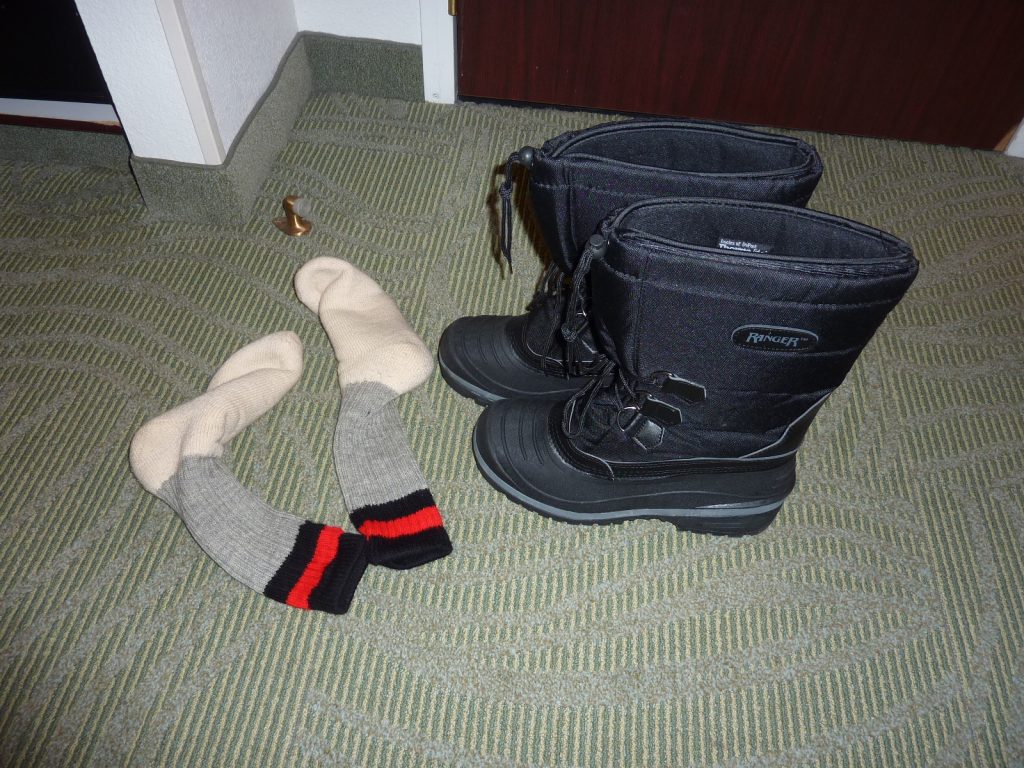
Hand warmers, toe warmers: put those in pockets or shoes to keep hands/feet warm. They are disposable and will generally work for 5 to 7 hours.
Parka: consider a parka rated to -20 deg F or even colder. Remember you will likely be sitting/standing for a considerable time and the longer you remain in one position, the colder you will get. You should have well nested interior pockets and exterior zippered pockets for putting key items for photography, flashlight, etc.
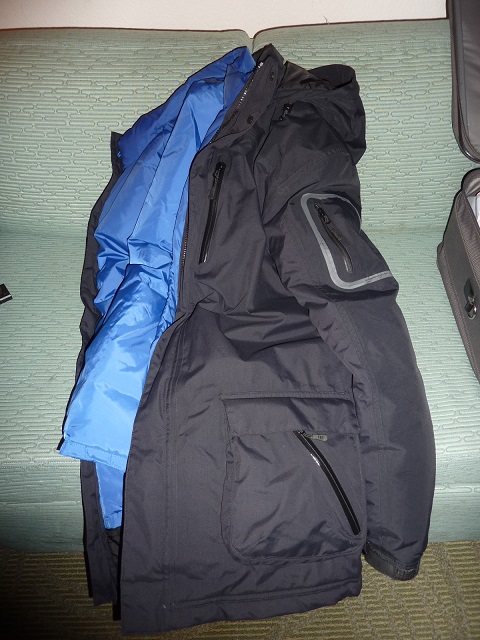
Ski pants: these are a really good idea since they protect from wind as well as ambient cold. A snow mobile suit can also be very helpful in shielding the majority of your limbs.

Thermal underwear: not always necessary but they provide an extra internal layer of protection for upper torso and lower body
Gloves: if you are photographing you will need thin but well insulated wool gloves. If not, ski gloves, also well padded are a must
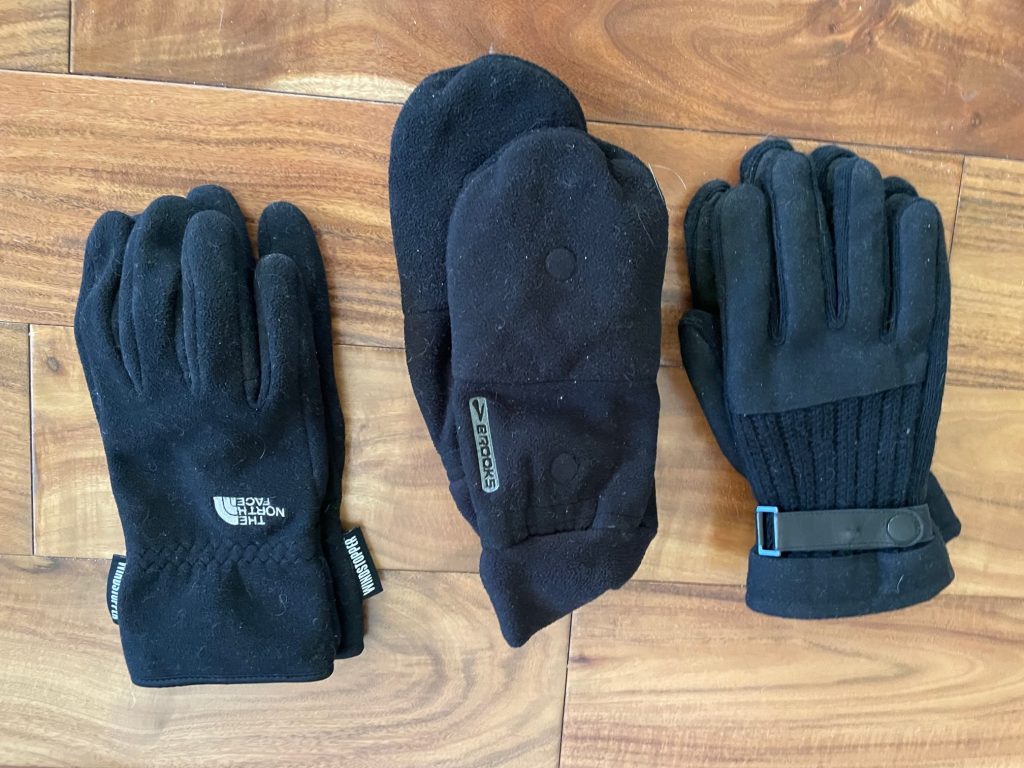
Hat: fur lined hat will protect your head and ears. If it is predicted to be below zero a Siberian hat as shown below gives you added protection.
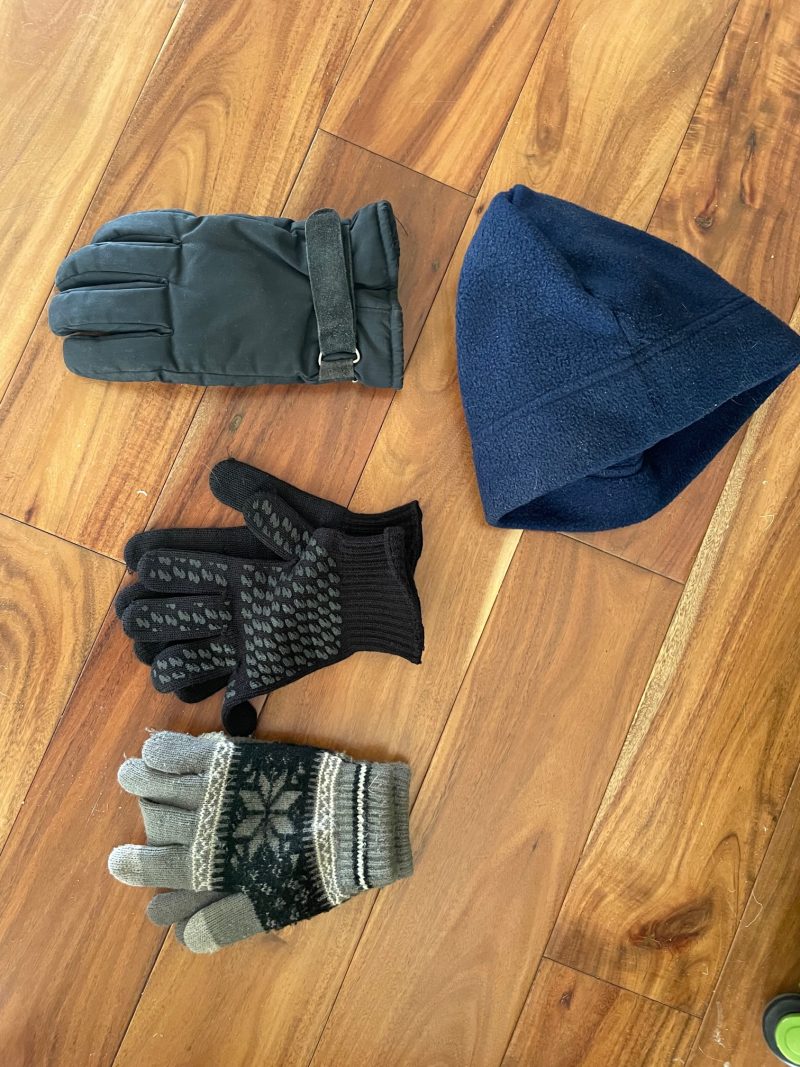
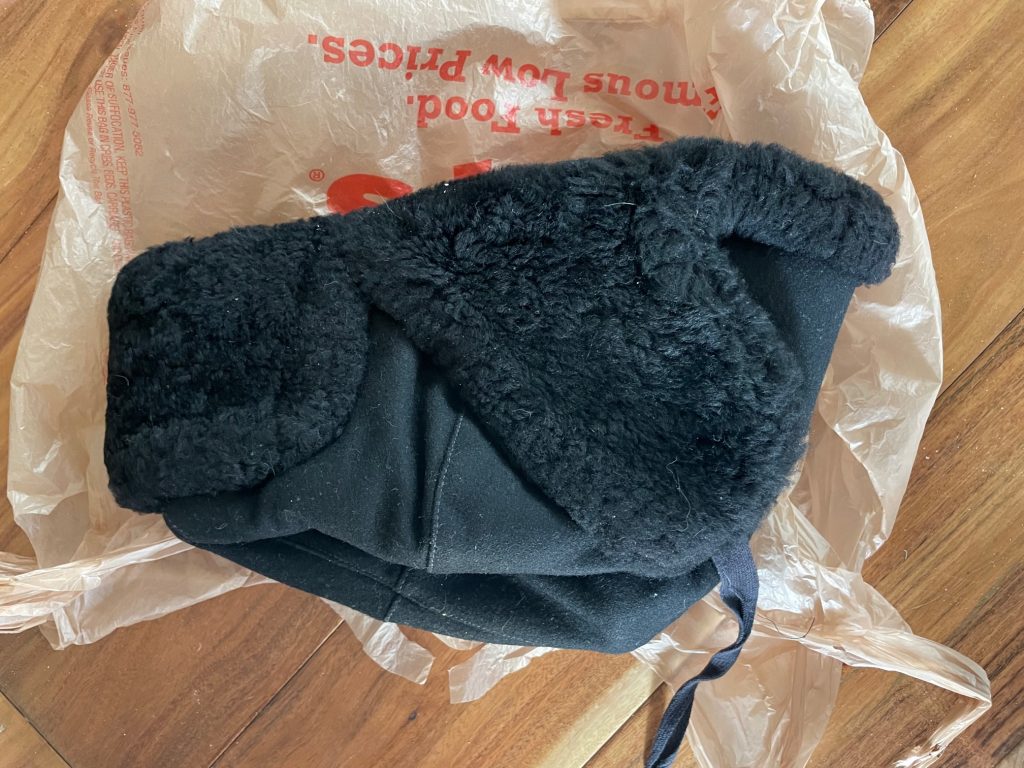
Gator: good for neck protection
Face mask: also great for protecting facial skin but tricky to use especially when wearing glasses. I have never had good luck preventing my glasses from fogging up. However, putting anti-fog spray on your glasses is one mitigation measure for that.
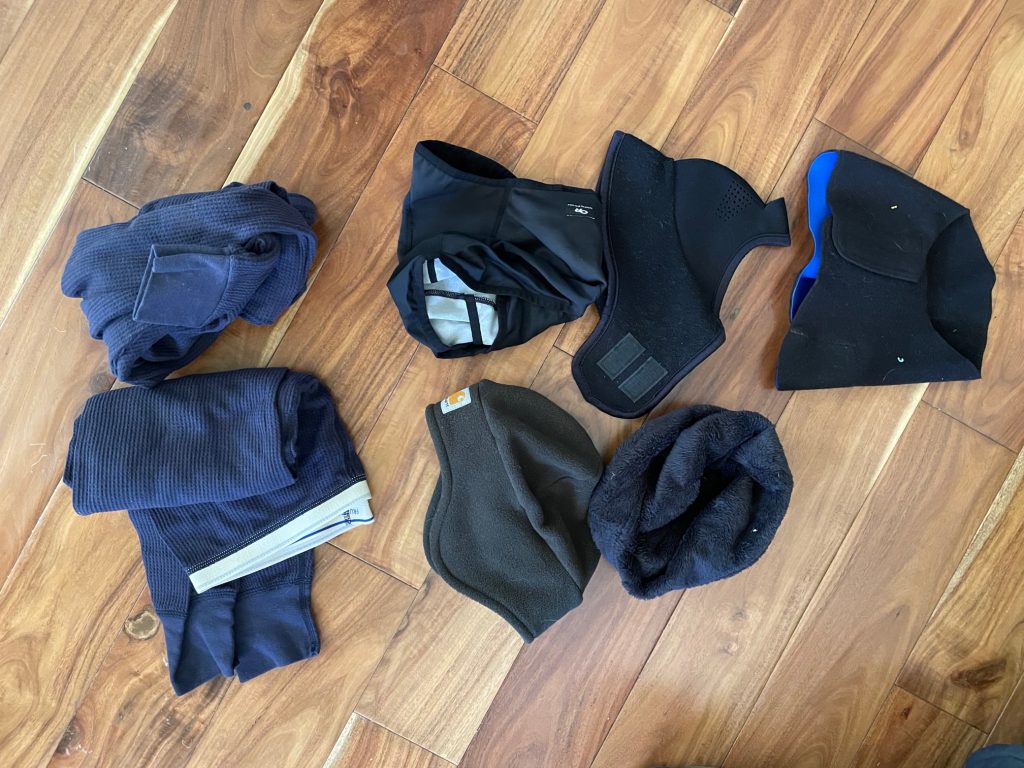
DINNER ENTREE OPTIONS
The lodge prepares 6 different entrees. They are shown below as 1) shrimp scampi, 2) chicken cordon bleu, 3) vegetarian option, 4) New York Steak, 5) grilled salmon, 6) grilled halibut.
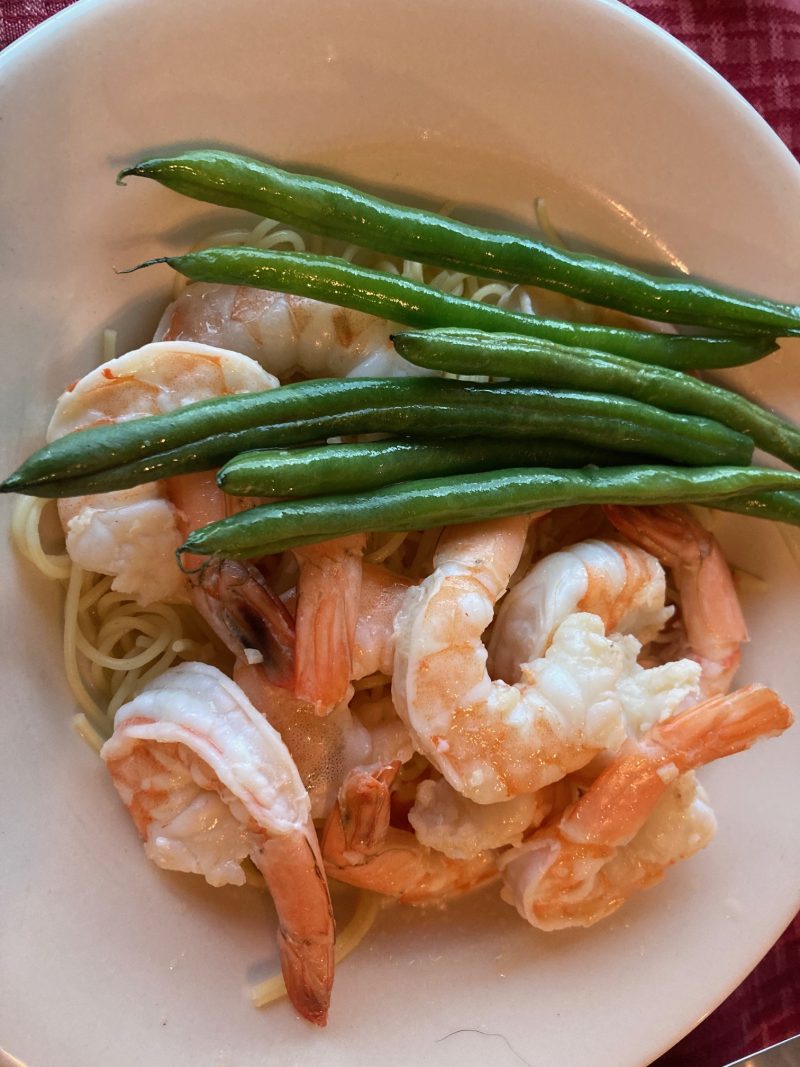
Shrimp Scampi
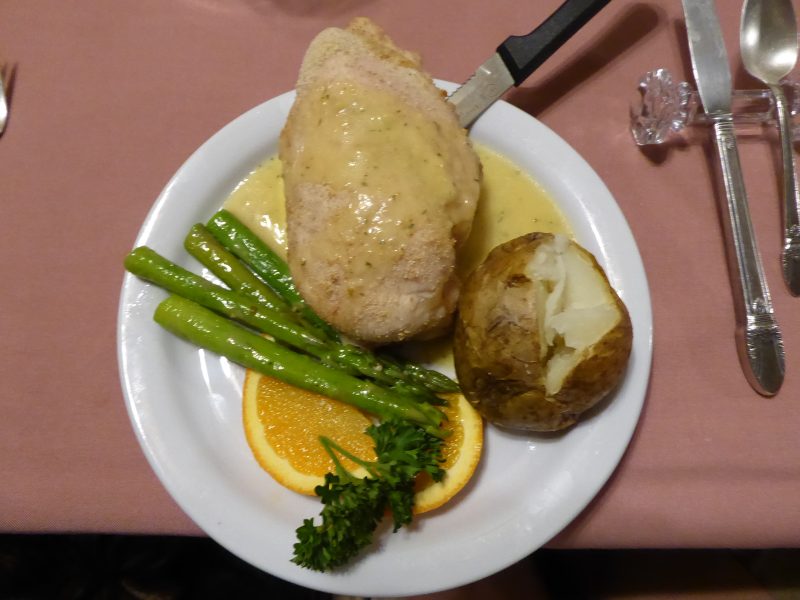
Chicken Cordon Bleu

Vegetarian (example only and may vary)
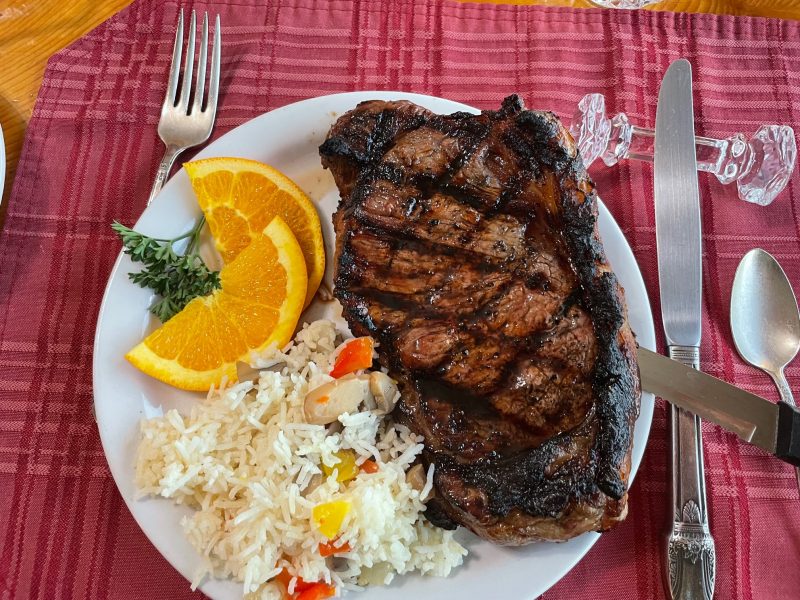
New York Steak

Grilled Salmon

Grilled Halibut
FALL CLOTHING
Up until October 1 a coat, gloves (light and heavier), and maybe ski pants, and light hat are enough to keep you warm. There is a log cabin near the viewing area and you can always retreat there if you are not warm enough. After October 1 look for when snow is falling and then begin to consider winter clothing as outlined above. Always look at the advanced weather forecast about 7 days before you depart for Alaska to get a better idea of how to dress.
IF YOU ARE A PLANNING PHOTOGRAPHY OF AURORAS
In order to be successful you must not only bring the proper gear but be sure you have taken test exposures on stars at night and can see pinpoint in-focus star images. You will need to manually set your camera with the proper speed (ISO) [generally 1600-3200], exposure time (generally 4 to 20 seconds), use a lens at least 28mm or smaller in focal length, shutter release to set the exposure time and verify you can manually focus on stars. Bring your manual for reference if you are not completely familiar with camera operation. DO NOT plan to hand hold your camera! Never use a flash! Always bring a sturdy tripod. If you do not test your camera prior to the trip, chances are you will most likely completely fail at aurora photography.
TEMPER YOUR EXPECTATIONS
If you have never seen aurora before you should be aware of these realities:
a. though we normally schedule our expeditions around New Moon, even if the sky is perfectly clear, it is possible NOT to see aurora if there is no solar activity to kick off a disturbance in the Earth’s magnetic field.
b. when there is aurora activity, it can often be seen if the sky is partly cloudy and on some occasions can light up the cloud even if the sky IS cloudy.
c. aurora can also be seen even with the Full Moon.
d. aurora can be impossible or extremely difficult to see (much less photograph) if inside a well lit city.
e. weather forecasts and solar activity forecasts, regardless of the source, should be taken with a grain of salt.
f. aurora photography with a point and shoot camera is generally useless and will irritate those around you if your flash goes off. We do not allow flash cameras at our (exclusive) observation venues. But it may be possible to photograph bright aurora with a smart phone camera! A downloadable app for this purpose can help.
g. when you see your first really good auroral display it will be a thrill of a lifetime.
h. do not be deterred by the cold or even by the presence of cloud. Be persistent. If you have multiple nights, check every hour or two when it is overcast. In northern climates, skies an often become clear or partly cloudy for a short time or for very long periods without warning.
i. although we transport guests between Fairbanks International Airport and the lodge you might consider to rent a car. It will give you more flexibility to explore the area but we caution not to do so after snow is on the ground as roads can be treacherous.
The photo to your right looks terrible. In reality there is plenty of cloud but three indications of aurora. The bright green glow behind the trees indicates something is happening low on the horizon to the north. That glow might be mistaken for car headlights. In the far right side of the photo, there is a faint green auroral glow. Then to the left of the cloud there is a very faint light green aurora glow. Visually you might not recognize these indicators, especially if you just stepped outside and your first conclusion was that it was mostly cloudy.
j. Aurora can appear for a few seconds to minutes in one area and then vanish. It can become intense in a matter of seconds (or not). It can move around the sky or remain entire stationary on a time scale of seconds to minutes or even longer.
k. a sign of minimal activity may be a faint green static arc that lasts for a significant period of time but does not change in intensity.
l. the appearance of extremely intense aurora have, on extremely rare occasion, been linked to sounds heard by a few observers. I have not met anyone who has experienced this phenomenon.
m. aurora can appear white, green, red and even blue though the most common visual color is green.
n. the camera can always record more than the eye but the visual experience can be extraordinary.
o. aurora can take on the appearance of a slow or rapidly moving set of piano keys or an accordion, essentially a curtain with well defined linear structures.
p. someone may tell you that aurora can only be seen during certain hours, for example between 1030pm and 230am. Look any time the sky is dark. You never know what will happen. Be patient and persistent!
q. aurora can likely be expected within 2 days after a very strong solar flare has been initiated. Sometimes the effects of that stream of high energy particles can linger for several days causing light to moderate auroras or even strong auroras to be seen.
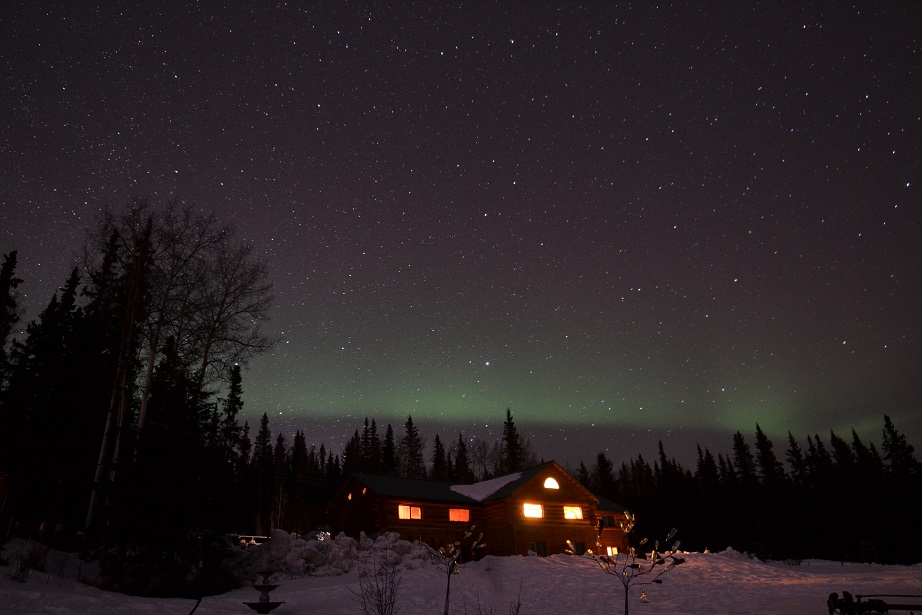
First indication of aurora activity. P. Maley photo.
By far, we have found that lodges in Fairbanks DO NOT follow the guidelines listed here. Even so, you might find that going to nearby lodges are your best bet. If you are purist, this means that if you want to avoid interference to aurora photography, you should consider to get far away from the very places that are supposed to have your best interests in mind. In the end, it may mean renting a vehicle and driving to some uninhabited road or view point rather than waiting at a place that is advertised to be warm, have comfortable facilities, etc.
AURORA VIEWING SAFETY AND SUCCESS ITEMS FOR LODGES
Because aurora photography is generally the primary goal of serious aurora observers and involve time exposures from 5 to 30 seconds or longer, CHECK TO SEE IF YOUR HOTEL OR LODGE DOES THESE THINGS! If they do not, you will need to cope with these potential issues.
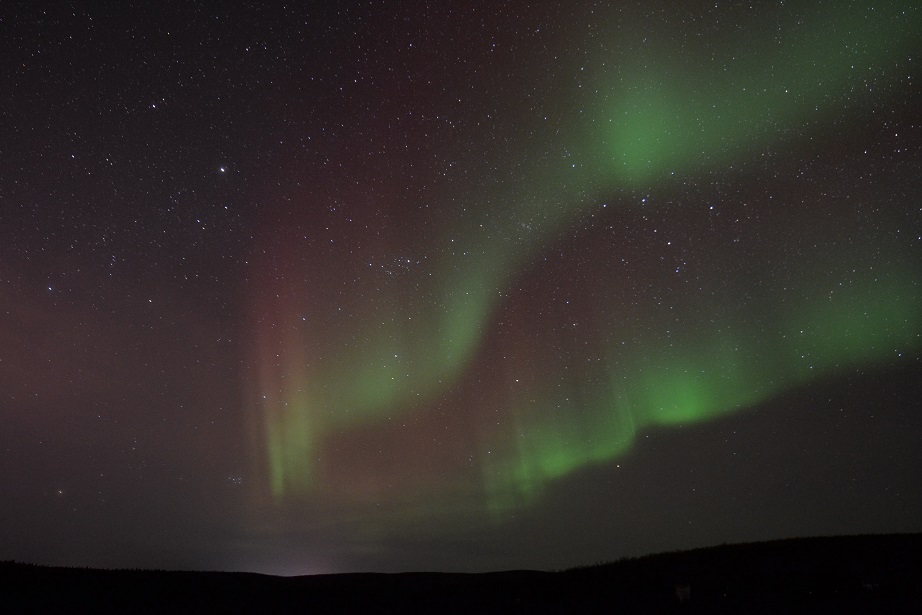
Aurora curtains are one of the exciting outcomes of a successful night of viewing. P. Maley photo. ISO800, 30 seconds exposure, 14mm f/2.8.
1. limits the number of guests so that you are not competing with 50 or even as many as 150 other aurora viewers. If this is not the case, consider to avoid this venue.
2. has posted signs for arriving vehicles to TURN OFF THEIR LIGHTS AFTER 10PM. The hours between 10pm and 230am are roughly (but not always) the major time period for auroral activity.
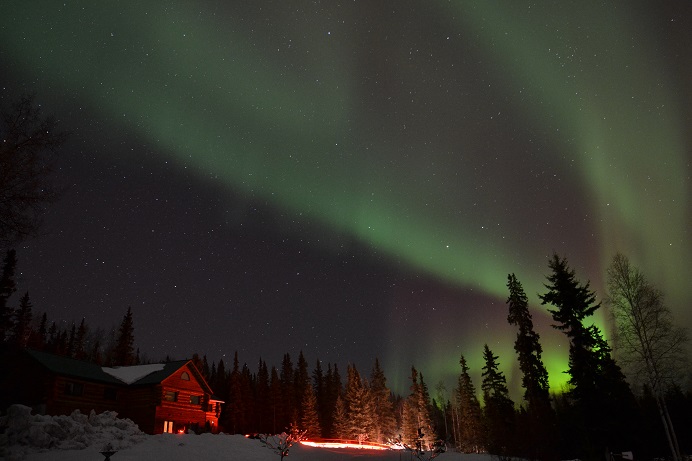
Photo above shows car lights that moved quickly through the frame but not directed at the camera. This is a mild form of light pollution. P. Maley photo.
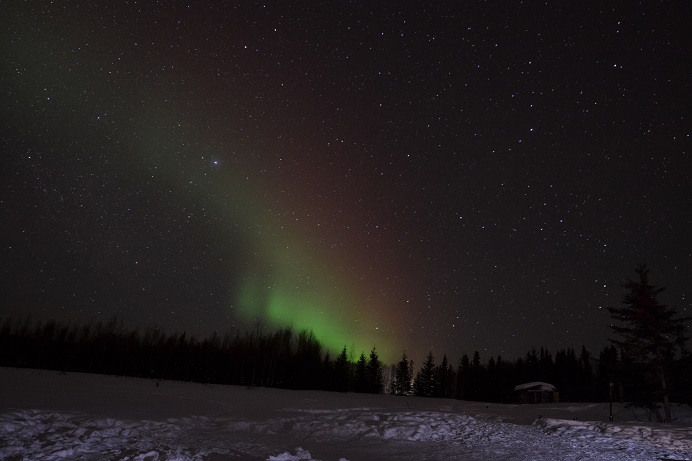
Another example where car lights glisten off snow in front of the camera. P. Maley photo.
3. blocks building windows to ensure white light does not spill out around the venue limiting where you can set up your camera.
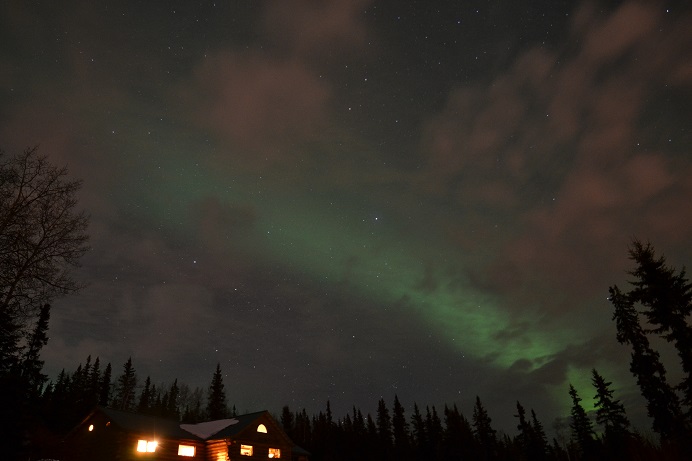
Lights on in a lodge room (left side). P. Maley photo.
4. educates all guests and employees on proper aurora viewing practices
5. bans use of white lights of any kind after 10pm and enforces a red light only policy.
6. during winter time, grades potential snow trip hazards. This is a potentially serious problem and we have been at Fairbanks locations where guests have fallen / become injured, have dropped items in the snow or damaged equipment through a trip / fall.
7. bans the use of headlamps
8. bans the use of flash attachments on cameras.
9. caution room residents who are staying at the venue to turn off their room lights after 10pm and not to shine white lights out the room windows.
10. OPTIONAL: vendors should consider providing snowshoes so serious photographers can venture far away from the main viewing area to get away from interference.
11. At lodges it is not uncommon to have non English speaking guests. Be aware that they may not know the proper aurora viewing protocol and do things like walk in front of your camera or use white flash lights.
PAUL MALEY’S AURORA ACTIVITY RATING SCALE
These are my personal ratings on the level of Northern Lights activity that you might see:
0…No activity at all. Stars visible.
1…White aurora patches looking like faint cirrus clouds. If you take a time exposure they will appear light green in color. If the photo does not show green in color then you are seeing cirrus clouds.
2…Large green arcs usually starting low on the north horizon. Faint in intensity. Arcs do not move much if at all, then fading out.
3…Large green arcs of moderate intensity slowly moving from north to south over a period of many minutes or hours
4…Green arcs/bands slowly changing form; one or more bands may stretch from horizon to horizon.
5…Green areas varying in size, intensity and form on a time scale of a number of seconds. Some other shapes such as curtains, streaks or irregular patches accompany them.
6…Brighter green and/or reddish shapes of varying forms appearing/disappearing in different parts of the sky
7…Curtains shimmering in a rapid time sequence on the order of seconds. Bands, rays, streaks of different sizes/intensities moving or relatively stationary at times. Forms popping up in one place, then in a different place or reappearing with varying intensity. Some forms become huge and expansive.
8…Intense coronal features at the zenith with variable intensity features in many parts of the sky. You will need to reduce ISO or exposure time to avoid overexposure and saturation.
9…Red, green, purple, white extremely intense aurora capable of lighting up the ground. Rapid time scale changes.
DISSIPATION PHASE
After high levels of aurora activity that cover the entire sky, the sky itself may take on a dull gray overcast appearance signifying the end of a major auroral episode.
OTHER PHENOMENA THAT MIGHT BE SEEN
STEVE stands for Strong Thermal Emission Velocity Enhancement and appears to be quite different from an aurora. A purple ribbon of light may appear without warning that signals this phenomenon. It is rare in the sense that we have never seen it in our numerous aurora viewing expeditions. Auroras occur when charged particles emitted by the Sun collide with the Earth’s atmosphere, imparting energy to the molecules there that is subsequently released as light. The result is a dazzling, dancing light show that has fascinated skygazers and facilitated scientific discoveries about our planet, our Sun, and the way they interact. Though the aurora is relatively well studied, it still holds surprises. STEVE IS a vibrant, violet phenomenon known to amateur photographers and sky watchers for decades, but which only captured the attention of the professional scientific community around 2016.
LIGHT PILLARS
A light pillar is an atmospheric optical phenomenon in the form of a vertical band of light which appears to extend above and/or below a light source. Sometimes you cannot even spot the light source. The effect is created by the reflection of light from numerous tiny ice crystals suspended in the atmosphere or clouds. I have photographed these before from Svalbard and also from Fairbanks. The light can come from the Sun (usually when it is near or even below the horizon) in which case the phenomenon is called a sun pillar or solar pillar. It can also come from the Moon or from terrestrial sources such as streetlights.
USING AN IPHONE
There is at least one useful app called NightCapCamera that will allow for decent aurora images: https://www.nightcapcamera.com/aurora-photography-photograph-the-northern-lights-on-your-iphone-with-nightcap/
You should consult the internet to see other examples.